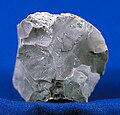Search results
Appearance
The page "Siliceous sediment" does not exist. You can create a draft and submit it for review or request that a redirect be created, but consider checking the search results below to see whether the topic is already covered.
- either the microscopic, calcareous or siliceous shells of phytoplankton or zooplankton; clay-size siliciclastic sediment; or some mixture of these. Trace amounts...9 KB (919 words) - 20:09, 1 March 2023
- Siliceous ooze is a type of biogenic pelagic sediment located on the deep ocean floor. Siliceous oozes are the least common of the deep sea sediments...25 KB (3,108 words) - 12:53, 6 June 2024
- Siliceous ooze is a type of biogenic pelagic sediment located on the deep ocean floor. Siliceous oozes are the least common of the deep sea sediments...109 KB (12,371 words) - 03:21, 16 May 2024
- Sediment is a naturally occurring material that is broken down by processes of weathering and erosion, and is subsequently transported by the action of...22 KB (2,812 words) - 01:47, 17 March 2024
- Sedimentary rock (redirect from Sediment bed)settle in place. The particles that form a sedimentary rock are called sediment, and may be composed of geological detritus (minerals) or biological detritus...63 KB (7,683 words) - 08:39, 25 June 2024
- Sediment transport is the movement of solid particles (sediment), typically due to a combination of gravity acting on the sediment, and the movement of...56 KB (8,282 words) - 08:15, 25 June 2024
- type of contact metamorphism known as pyroxene-hornfels facies, have siliceous sediment or basaltic protoliths, and are respectively metapelites and metabasites...6 KB (749 words) - 19:20, 18 January 2024
- Sedimentation (redirect from Sedimenting)Sedimentation is the deposition of sediments. It takes place when particles in suspension settle out of the fluid in which they are entrained and come...10 KB (1,713 words) - 15:11, 16 July 2024
- Amorphous volcanic glass Rock flour – Glacier-generated sediment Siliceous ooze – Biogenic pelagic sediment located on the deep ocean floor Zeolite – Microporous...40 KB (4,357 words) - 01:45, 9 August 2024
- approximately 2.65 g/cm3 (silica, siliceous sediments or aggregates), or 2.70 g/cm3 (calcite, carbonate sediments or aggregates), although a better estimation...23 KB (2,918 words) - 16:39, 9 June 2024
- Calcareous (section Marine sediments)at depth), stable, non-calcareous sediments such as siliceous ooze or pelagic red clay will prevail in marine sediment records. Calcareous soils are relatively...6 KB (670 words) - 05:12, 19 February 2024
- silica-glass. Hyalite is another name for this. Noncrystalline silica in siliceous sediments is reported to gradually transform to opal-CT and then opal-C as...56 KB (5,837 words) - 15:06, 27 August 2024
- Biogenous ooze (category Sediments)their dominance. Along some areas of terrigenous sediment are siliceous ooze. This is due to siliceous ooze being more abundant in areas of cooler, more...7 KB (857 words) - 11:31, 16 September 2023
- grain size. These criteria indicate that certain sediment types, such as abyssal clays and siliceous oozes, may have higher radiolytic H2 production relative...13 KB (1,732 words) - 19:00, 30 July 2024
- In oceanography and limnology, the sediment–water interface is the boundary between bed sediment and the overlying water column. The term usually refers...14 KB (1,610 words) - 21:15, 4 June 2024
- Chert is typically composed of the petrified remains of siliceous ooze, the biogenic sediment that covers large areas of the deep ocean floor, and which...35 KB (4,221 words) - 23:05, 30 July 2024
- preservation and rare arsenic-antimony-sulphide bioimmobilization in siliceous sediments from Champagne Pool hot spring, Waiotapu, New Zealand". Journal of...8 KB (718 words) - 06:46, 12 April 2024
- quartzite has created high-relief circular cuestas. Its center consists of a siliceous breccia covering an area that is at least 30 kilometres (19 mi) in diameter...23 KB (2,329 words) - 15:19, 27 August 2024
- Microfossil (section Siliceous)Siliceous ooze is a type of biogenic pelagic sediment located on the deep ocean floor. Siliceous oozes are the least common of the deep sea sediments...61 KB (6,330 words) - 20:00, 20 August 2024
- natural course the siliceous covering sinks to the bottom of the water in which it had lived, and there forms part of the sediment. When in the process
- the amorphous form known technically as opal. To be classed as siliceous ooze, sediment needs to be composed at least 30% of this material. The pictures
















